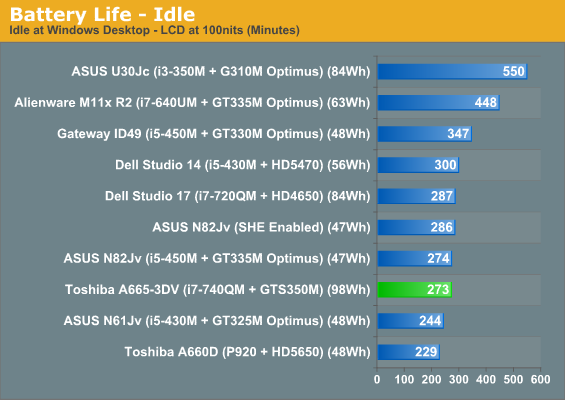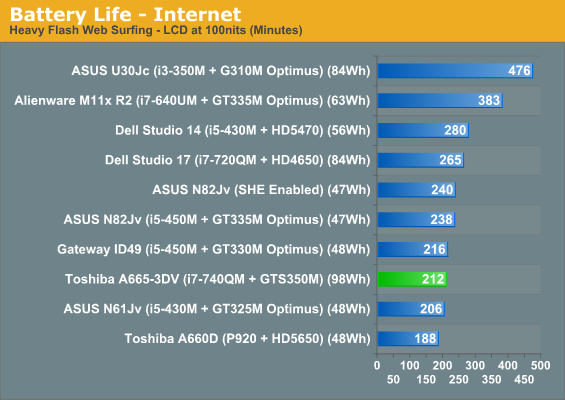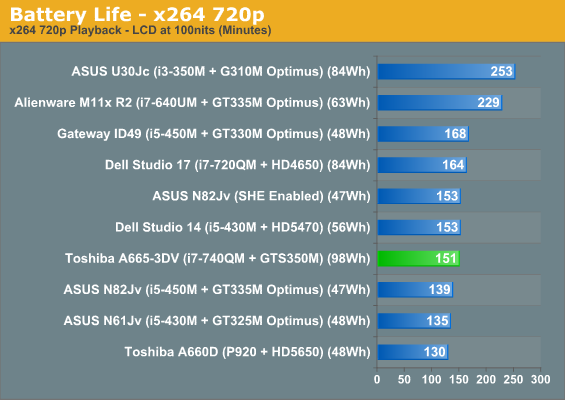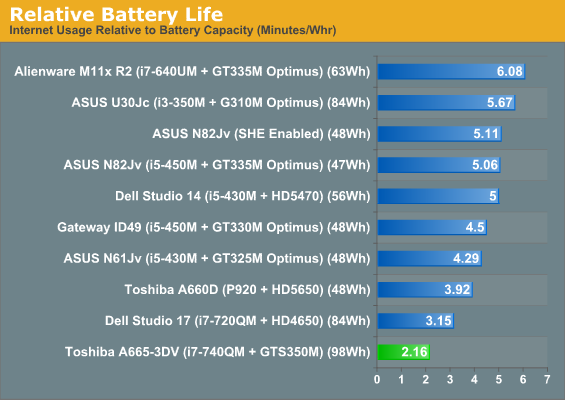Toshiba A665-3DV: 3D or Not 3D?
by Jarred Walton on October 6, 2010 12:05 AM ESTBig Battery for Okay Battery Life
With relatively high-end components and no switchable graphics, battery life is understandably not going to set any records. However, Toshiba does make some amends here by stuffing in a gigantic 12-cell 98Wh battery. The result is that while the system uses quite a bit of power, it can still manage over four hours of battery life in ideal circumstances. We set the CPU for 0% performance (hey, a quad-core i7 with Hyper-Threading is still plenty fast even if locked to 933MHz) and calibrated the LCD to 100nits—58% for the A665-3DV.




Considering the performance, battery life is actually quite respectable. 4.5 hours at idle, 3.5 hours for Internet use, and 2.5 hours of x264 playback manages to beat out the ASUS N61Jv and the AMD-based Toshiba A660D. The catch of course is that the battery capacity is literally twice that of many of the other laptops in our list. If you want all-day mobility, you're still better off with something like the ASUS U30Jc. However, if you're after a quad-core notebook with a fairly fast GPU, the A665-3DV acquits itself well enough. Note of course that in the relative battery life metric, it does place dead last out of the tested laptops, with the other quad-core i7 (Dell Studio 17) one rung up the ladder.
(Incidentally, we're also looking into the ASUS U35Jc battery life a bit more to see if we can figure out why our figures are so much worse than the U30Jc; other sites are reporting better battery life on the U35Jc, so we're running some additional tests to see if we can track down the cause/resolution.)










13 Comments
View All Comments
EnzoFX - Wednesday, October 6, 2010 - link
Seems like another product on Anandtech that's not for the power users here =p. I still know people with 1280x800 on 15" laptops...nubie - Wednesday, October 6, 2010 - link
I admire that this is being sold, but am disappointed by the choice to use active glasses to display the content.This stems from the limitations of LCD refresh and the extra complexity associated with a Stereo-mirror or head-based stereoscopy system.
I admit I have dabbled in CAD and modeling, where a 3D display is very useful. Many on the internet are quick to poo-poo 3D for gaming, perhaps they are correct, for both the casual and enthusiast or professional gamer it isn't attractive. I find it quite immersive and useful myself.
I don't know if a laptop is quite the place for 3D gaming, but then laptops aren't really a good gaming platform anyway.
I wonder if you can retro-fit a 120hz panel into a higher-quality laptop with a better video card than this system? If you did could you get nVidia Vision to work? I don't really trust nVidia in this regard because they have locked down their support. Ideally to make it simpler to use for the consumer, but this makes it useless for those with "unsupported" hardware that in reality has decent specifications for 3D use.
Sabresiberian - Thursday, October 7, 2010 - link
I guess it must be a good decision for a manufacturer to put one in instead of a 7200 RPM one, because a lot of manufacturers of laptops do it, but when the price difference is a couple of dollars, literally, it doesn't impress me and it is one of the things that puts a laptop in the "no" column, for me. Okay for a $500 machine or less, I suppose, but not one in this price range.;)